

NoSQL Style (Gangnam Style Parody for Geeks) UC Berkeley Course Lectures: Analyzing Big Data With Twitter. The State of NoSQL in 2012. This is a guest post by Siddharth Anand, a senior member of LinkedIn's Distributed Data Systems team.
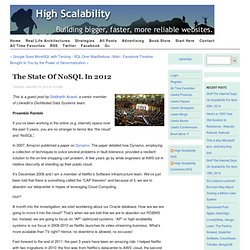
Preamble Ramble If you’ve been working in the online (e.g. internet) space over the past 3 years, you are no stranger to terms like “the cloud” and “NoSQL”. In 2007, Amazon published a paper on Dynamo. The paper detailed how Dynamo, employing a collection of techniques to solve several problems in fault-tolerance, provided a resilient solution to the on-line shopping cart problem. The Coming SQL Collapse. I looked at neo4j briefly the other day, and quite predictably thought ‘wow, this looks like a serious tinkertoy: it‘s basically a bunch of nodes where you just blob your attributes.‘ Worse than that, to wrap objects around it, you have to have them explicitly incorporate their node class, which is ugly, smelly, violates every law of separation of concerns and logical vs. physical models.
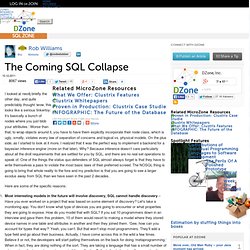
On the plus side, as I started to look at it more, I realized that it was the perfect way to implement a backend for a bayesian inference engine (more on that later). Why? Because inference doesn‘t care particularly about all the droll requirements that are settled for you by SQL, and there are no real set operations to speak of. One of the things the status quo defenders of SQL almost always forget is that they have to write themselves a pass to violate the most basic laws of their preferred screed.
Here are some of the specific reasons: From. Choosing a non-relational database; why we migrated from MySQL to MongoDB « Boxed Ice Blog.
HBase - HBase Home. Hypertable: An Open Source, High Performance, Scalable Database. Leveling the Field. July 1, 2011 For most Riak users, Bitcask is the obvious right storage engine to use.
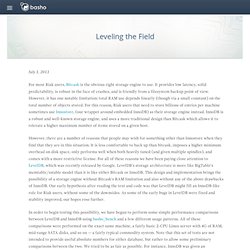
Cassandra vs MongoDB vs CouchDB vs Redis vs Riak vs HBase comparison. (Yes it's a long title, since people kept asking me to write about this and that too :) I do when it has a point.)

While SQL databases are insanely useful tools, their monopoly in the last decades is coming to an end. And it's just time: I can't even count the things that were forced into relational databases, but never really fitted them. (That being said, relational databases will always be the best for the stuff that has relations.) But, the differences between NoSQL databases are much bigger than ever was between one SQL database and another. Introduction to Redis - In Memory Key Value Datastore. We Recommend These Resources.
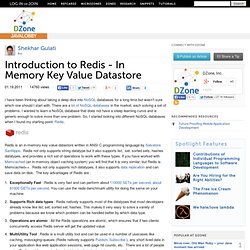
S tech blog » Why startups should not choose NoSQL. December 27, 2010 The NoSQL hype is omnipresent.

And many startups are tempted to go for Cassandra/MongoDB/HBase/Redis/… . Here I’ll argue why they should rather stick to a SQL solution – MySQL or PostgreSQL. Babudb - Project Hosting on Google Code. Banana DB - self-contained key/value pair database for java. Banana DB Banana DB is a self-contained key/value pair database implemented in Java.
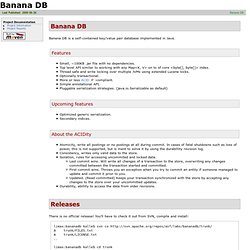
Features Small, ~100KB .jar file with no dependencies.Top level API similar to working with any Map<K, V> on to of core <byte[], byte[]> index.Thread safe and write locking over multiple JVMs using extended Lucene locks.Optionally transactional.More or less ACID -compliant.Simple annotational API.Pluggable serialization strategies. (java.io.Serializable as default) Upcoming features Optimized generic serialization.Secondary indices. Non-RDBM distributed databases, map/reduce, key/value and cloud computing. I've been playing recently with several distributed databases with the aim of choosing the best solution for my needs.

Since there isn't much documentation on the web with a general overview on the subject, I write here some comments, thoughts and my humble experience. Hope it's usefull for you, this document is not a comparison of performance, or a "mine is bigger than yours", just some ideas ;) My background Being my experience based on relational databases (like MySQL or Postgres) and Object oriented databases (like ZODB) it was very easy for me to get hooked on this new challenge, anything but the relational databases (no offense). Last year, in Mainz, Germany, and after having heard a lot of buzz on the subject, Jan Lehnardt gave an interesting lecture on CouchDB. Anti-RDBMS: A list of distributed key-value stores. Written on 19 January 2009 Please Note: this was written January 2009 - see the comments for updates and additional information.

Troubles with Sharding - What can we learn from the Foursquare Incident? For everything given something seems to be taken.
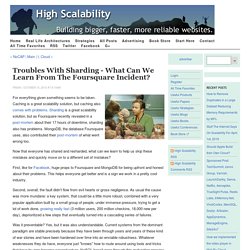
Caching is a great scalability solution, but caching also comes with problems. NOSQL Databases. NoSQL/Home Page. A Relational Database Management System NoSQL is a fast, portable, relational database management system without arbitrary limits, (other than memory and processor speed) that runs under, and interacts with, the UNIX1 Operating System. It uses the "Operator-Stream Paradigm" described in "Unix Review", March, 1991, page 24, entitled "A 4GL Language". There are a number of "operators" that each perform a unique function on the data. The "stream" is supplied by the UNIX Input/Output redirection mechanism. Therefore each operator processes some data and then passes it along to the next operator via the UNIX pipe function. A Lightweight SQL Database for Cloud and Web in Launchpad. Log in / Register A Lightweight SQL Database for Cloud Infrastructure and Web Applications Registered 2008-05-12 by Drizzle Developers The Drizzle project is building a database optimized for Cloud and Net applications.
It is being designed for massive concurrency on modern multi-cpu/core architecture. No to SQL? Anti-database movement gains stea. Eric Lai published a provoking article on Computerworld magazine titled “No to SQL? Anti-database movement gains steam” where he pointed to many references in which different Internet-based companies chose an alternative approach to the traditional SQL database. The write-up was driven from the the inaugural get-together of the burgeoning NoSQL community who seem to represent a growing Anti-SQL database movement.
Quoting Jon Travis from this article: Relational databases give you too much. They force you to twist your object data to fit a RDBMS [relational database management system], The article points to specific examples that led different companies such as Google, Amazon, Facebook to choose an alternative approach. Demand for extremely large scale: “BigTable, is used by local search engine Zvents Inc. to write 1 billion cells of data per day.” Complexity and cost of setting up database clusters: Most Trendy Graph Databases. We Recommend These Resources The last two years of my working life I been at the UPC , specifically with the DAMA-UPC research group: the data management experts of this university. One of the lines of research is graph databases, which is the main topic of this post.
In the same way that relational databases organize data in the form of tables, graph databases do this in the form of a graph, or a network. Nodes, edges, attributes and algorithms are the objects of interest in this field. NoSQL Graph Database Comparison. A few days ago I published a short overview of the most trendy graph databases. Today I'm bringing you a review of the most important features of them. As you can see the current ecosystem is quite bit, without general uniformity, although this is normal when analyzing an ongoing technology movement.